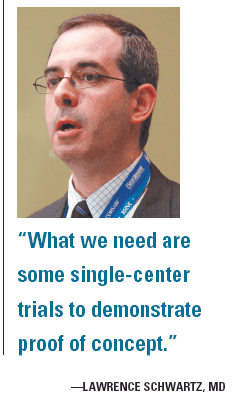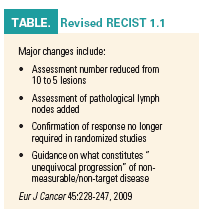Changing paradigms for tumor response spark debate at ECR special focus session
VIENNA-Yes, size does matter, but it is certainly not the only way to monitor the effi cacy of cancer treatment. Th e way in which lesions are measured is extremely important as well, according to a special focus session on the assessment of tumor response at the 2009 European Congress of Radiology.
ABSTRACT: For half a century, shifts in tumor size have been the main criteria to assess therapy response. But novel treatment therapies require new ways to measure success.
VIENNA-Yes, size does matter, but it is certainly not the only way to monitor the efficacy of cancer treatment. The way in which lesions are measured is extremely important as well, according to a special focus session on the assessment of tumor response at the 2009 European Congress of Radiology.
For the past 50 years, imaging has been regarded as a substitute or surrogate marker to assess therapy response, with the most widely used criterion being a change in size, said Rodney H. Reznek, FRCR, FRCP. Th e development of chemotherapy drugs that act on cancers in novel ways, such as agents that are cytostatic rather than cytotoxic, has led to questions about the universal suitability of this strategy. “It has become apparent that size may not be the most sensible or reliable criteria to assess response. For this reason, other biomarkers are being used, one of which is functional imaging,” said Dr. Reznek, who is a professor of diagnostic imaging at St. Bartholomew’s Hospital in London (ECR SF1A).
Of course, size is not being abandoned altogether. Th e problem is that the correlation between tumor shrinkage as measured on CT and patient survival is not quite as strong as might be expected, said Lawrence Schwartz, MD, chief of MRI at New York’s Memorial Sloan-Kettering Cancer Center.

“So while we are doing OK, we really haven’t yet optimized tumor response assessment,” he said.
Th e size-based criteria that are used to decide how cancer patients in clinical trials have responded completely to their treatment have recently been changed. Version 1.1 of RECIST still requires that unidimensional measurements be made of target lesions. Th e overall tumor burden will also still be defi ned according to the sum of lesion diameters (see Table). What is diff erent, however, is the selection of target lesions. RECIST 1.1 states that up to fi ve lesions should be measured, with a limit of two per organ. Th is replaces the previous RECIST guidance to measure 10 lesions (fi ve per organ). Another change is that the criteria for “progressive disease” require not only a 20% increase in size but that this change should be greater than 5 mm.
All ongoing clinical trials should stick with the original version of RECIST, Dr. Schwartz said. Th is means that the revised criteria will not actually be used for several more months yet.
PET/CT is the main modality in the move to functional imaging for therapy response. For some cancers, such aslymphoma, FDG-PET/CT has become a standard way of measuring tumor response at the end of treatment, said Wolfgang A. Weber, MD, chair of nuclear medicine at the University of Freiburg in Germany. Th is is achieved by simply comparing a pretherapy baseline scan against the results of post-therapy imaging.
FDG-PET/CT is also being investigated as a predictive tool. With so many diff erent drugs becoming available, it would be helpful for oncologists to know sooner rather than later whether their chosen agent is likely to work. Research is under way to see whether the results of an FDG-PET/CT scan aft er the fi rst cycle of chemotherapy could be a good indicator of patient outcome.
FDG-PET/CT is not the only functional imaging option. Many MR-based methods could equally be used to evaluate tumor response to therapy, according to Anwar Padhani, MB, FRCP, FRCR, a consultant radiologist and director of clinical research at the Mount Vernon Cancer Centre in London.
Dr. Padhani outlined a range of MRI techniques that can support decision making in clinical trials of new cancer drugs. Th ese included MR spectroscopy to monitor altered metabolism, blood oxygen level-dependent MRI to identify hypoxia, diff usion MRI to assess cellular density and tissue structure, and dynamic contrast enhanced MRI to monitor angiogenesis through tissue perfusion.
He highlighted a number of key questions that still need to be addressed as this role for imaging proceeds: How do we take this information and integrate it into a patient study? How do we correlate changes we are seeing with patient outcomes? How do we develop common measurement and analysis methods so we can standardize these and use them in multicenter studies?

Th e Quantitative Imaging Biomarker Alliance, formed by the RSNA, is looking at this latter issue, Dr. Schwartz said. Questions from ECR delegates to the speakers on the potential role of yet more functional imaging techniques stressed the need for clarity on this topic. For example, radiology researchers in France are investigating the role of ultrasound as a tool for tissue perfusion measurements. Dynamic contrast-enhanced imaging may also be performed on CT, rather than MRI, and the results combined with PET.
“What we need are some single-center trials to demonstrate proof of concept, to work out the reproducibility of the techniques, and then to move that in a very rigorous and rapid way into phase III trials,” Dr. Schwartz said.
Newsletter
Stay up to date on recent advances in the multidisciplinary approach to cancer.
Elevating the Quality of Cancer Care via Cross-Department Collaboration
Experts from Sibley Memorial Hospital discuss how multidisciplinary work has enhanced outcomes such as survival and resource use at their institution.